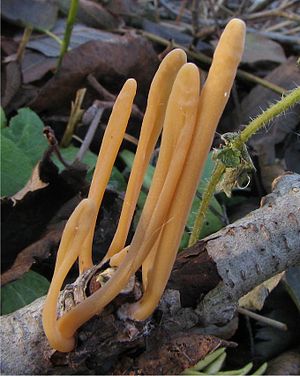Tubular club
| Tubular club | ||||||||||||
|---|---|---|---|---|---|---|---|---|---|---|---|---|

Tubular club ( Macrotyphula fistulosa ) |
||||||||||||
| Systematics | ||||||||||||
|
||||||||||||
| Scientific name | ||||||||||||
| Macrotyphula fistulosa | ||||||||||||
| ( Holmsk .: Fr. ) RH Petersen |
The tubular club ( Macrotyphula fistulosa ), also called blunt tubular club or high tubular club , is a relatively rare type of mushroom that, despite the lamellar fruiting body, is one of the mushroom- like types .
features
Macroscopic features
The fruiting bodies are 5 to 20 cm long and 4 to 5 mm wide - stunted specimens often only reach a length of 1 to 3 cm. They are initially pale yellow and later reddish brown to brown in color. The fruit bodies are very slender, hollow and mostly unbranched. Occasionally there are also bifurcated specimens. The meat has a stiff but pliable consistency and becomes limp with age. The surface is longitudinally wrinkled or smooth. At the top, the fruit bodies are rounded or slightly pointed, and underneath they are slightly thickened. At the base there is a short, shaggy and root-like extension. The spore powder is whitish in color.
Microscopic features
The elliptical spores are pointed on one side, hyaline and smooth-walled. They measure 12 to 18 µm in length and 5 to 7 µm in width.
variability
Some authors differentiate between the contorta variety and fruit bodies that are only a few centimeters in size and look like stunted tubular clubs. The more common M. fistulosa s. st. Separated without a root from the rare M. rigida with a long, rough-haired root. However, Gminder et al. point out that with a lot of experience and critical comparison one comes to the conclusion that the var. contorta is a pure form of starvation and that M. rigida only arises from M. fistulosa as a result of the weather .
Species delimitation
The tubular club is characterized by its size, slim shape and the growth of dead wood. The rush club ( M. filiformis ) is similar , but it is significantly thinner (approx. 1 mm) and grows on fallen leaves. Species of the genus Clavariadelphus are significantly thicker (several centimeters), grow on the ground and are not hollow. Below is the small club of the tongue ( C. ligula ), which is only about 6 cm in size and is a little more yellow in color; it also grows on the soil of coniferous forests.
ecology
The fungus is typical in warm, humid beech forests. It can also be found on hazel , alder and maple trees . There he can be found on roadsides and embankments. The club mushroom grows on branches and twigs lying on the ground, which can also be buried. The fungus prefers base-rich soils and can hardly be found on base-poor or summer-dry subsoil. In a few years the species is quite common, especially after heavy rainfall. The fruiting bodies appear between late September and November, often only after the first ground frost. They seldom appear earlier. The fruiting bodies can survive into the following year.
distribution
The tubular club is submeridional to temperate in the Holarctic . It can be found in Japan, North America and Europe. In Europe, the distribution ranges from France to Sweden and Finland and from Great Britain to Poland and Hungary. In Germany the Röhrige Keule is widespread everywhere, but locally quite scattered.
swell
literature
- German Josef Krieglsteiner (Eds.), Andreas Gminder , Wulfard Winterhoff: Die Großpilze Baden-Württemberg . Volume 2: Stand mushrooms: inguinal, club, coral and stubble mushrooms, belly mushrooms, boletus and deaf mushrooms. Ulmer, Stuttgart 2000, ISBN 3-8001-3531-0 .
- Ewald Gerhardt: FSVO manual mushrooms . BLV, Munich 2006, ISBN 3-8354-0053-3 .

